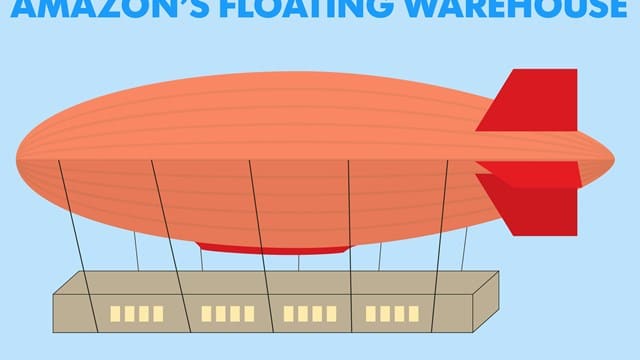Amazon has been experimenting with drone deliveries for quite some time and now it seems that the e-commerce behemoth is keen to go beyond the hustle and bustle of land-based shipments to exploit the potential offered by the open skies.
In the latest, Amazon plans to build a giant flying warehouse that will be used as a launchpad to deliver goods within a few minutes, according to a patent granted by the U.S. Patent and Trademark office to the online mega retailer for an ‘airborne fulfillment center (AFC) utilizing unmanned aerial vehicles for item delivery.’ The patent was actually filed back in 2014 and awarded in April this year, but came to light only on December 29 when it was discovered by CB Insights tech analyst Zoe Leavitt-
Warehouses In The Sky! How Will This Entire Thing Work?
According to Amazon’s ambitions plan, the floating warehouse, will be part of an airship flying at an altitude of 45,000 feet or more, and would store items to be sold through the company’s platform. These items would be picked up from the warehouse by drones and transported to the customer’s home. Here is how the entire process would work-
- First of all, a huge blimp will be used by the company to float it above a city.
- A giant warehouse stocking Amazon items would be attached to the bottom of the ship- whether this will be done before or after the ship is floated, it’s not clear right now.
- Danger of stocks running out? No problem. Smaller airships will carry staff and supplies from the ground to restock, and also dispose waste.
- Orders are made by customers on the ground, based on the items stocked in the warehouse.
- The items are grabbed by drones which fly out of the airship and approach the ground, where it is received by the customer. On completion of the delivery, the drone returns to the warehouse.
Another interesting point is that the patent also includes plans for advertising on the blimp. According to a flowchart included in, any product that is being advertised can be ordered. Imagine the new PlayStation or Samsung phone being advertised and receiving the new gadget in an instant through a drone! According to the filing, the warehouse blimp will be likely used at big events e.g. a football match or areas where the demand is high.
Amazon’s Far-Fetched Plans May Well Be The Future Of E-Commerce Delivery
One of the key factors governing the success of any online retail company are the logistics and how efficiently they are implemented. In recent years, Amazon has been working on testing drone deliveries through its Prime Air program, thus aiming to reduce its dependence on logistics companies for deliveries. The company made its first successful drone delivery in the U.K. earlier in December, and plans to further expand its drone trials to eventually automate a significant part (particularly lightweight packages) of its logistics operations.
Currently, Amazon has to build warehouses in a specific area for its drone deliveries. These warehouses stock a selection of lightweight products that are delivered to the customer as per the order within 30 minutes.
A major issue with this is that drone deliveries can only cover a certain distance, so to accommodate a large number of orders globally, the e-tailer would have to set up a large number of warehouses in different locations around the world. This can be a daunting task, considering the space crunch and difficulties in gaining approval from relevant authorities.
‘The use of an AFC and shuttles also provides another benefit in that the AFC can remain airborne for extended periods of time. In addition, because the AFC is airborne, it is not limited to a fixed location like a traditional ground based materials handling facility. In contrast, it can navigate to different areas depending on a variety of factors, such as weather, expected demand, and/or actual demand,’ says Amazon in its patent description, thus doing away with the headache of spending resources on land-based warehouses.
Will We See An Amazon Blimp Soon In the Sky?
Seems unlikely, especially in the near-term. Stringent drone regulations in the U.S. by the Federal Aviation Administration as well as most other countries will act as a big deterrent for autonomous deliveries, considering that they mandate all drones to be within the line of sight of a human pilot. Also, let’s not ignore the fact that many companies file patents on technologies that may actually never see the light of the day. Amazon has not responded yet, so it will be interesting to see whether they issue any statement on the same.












Leave a Reply